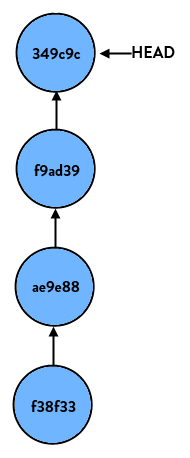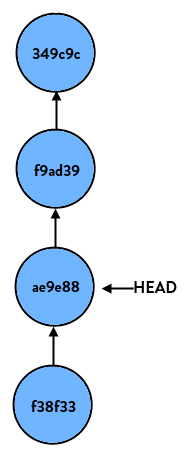git reset 之 soft mixed hard选项的区别
来源:互联网 发布:啊哈算法2 pdf 编辑:程序博客网 时间:2024/05/20 01:10
译注:为了避免丢失本地的修改以及original HEAD,建议在进行reset操作之前,在本地创建一个新的branch,在新的branch上面进行reset,以保证master分支永远处于original HEAD
以下为转发的正文
The reset command. Confusing. Misunderstood. Misused. But it doesn’t need to be that way! It’s really not too confusing once you figure out what’s going on.
Definitions
首先,让我们来解释几个定义.
First, let’s define a few terms.
HEAD(头)
指向当前branch最顶端的一个commit,该分支上一次commit后的节点
This is an alias for the tip of the current branch, which is the most recent commit you have made to that branch.
Index(索引)
The index, 也可以被认为是staging area(暂存区),是一堆将在下一次commit中提交的文件,提交之后它就是HEAD的父节点.(译注:git add添加的文件)
The index, also known as the staging area, is the set of files that will become the next commit. It is also the commit that will become HEAD’s parent.
Working Copy(工作副本)
当前工作目录下的文件,(译注:一般指,有修改,没有git add,没有git commit的文件)
This is the term for the current set of files you’re working on in your file system.
Flow(流程如下)
当你第一次checkout一个新的分支,HEAD指向该分支上最近一次commit。它和index和working copy是一样一样的。
When you first checkout a branch, HEAD points to the most recent commit in the branch. The files in the HEAD (they aren’t technically files, they’re blobs but for the purposes of this discussion we can think of them as straight files) match that of the files in the index, and the files checked out in your working copy match HEAD and the index as well. All 3 are in an equal state, and Git is happy.
当你修改了一个文件,Git注意到了会说“哦,有些东西被改了”,你的working copy不再和index和HEAD相同了,所以当文件有改动,它会标记这些文件。
When you perform a modification to a file, Git notices and says “oh, hey, something has changed. Your working copy no longer matches the index and HEAD.”So it marks the file as changed.
然后,你执行git add命令,这条命令会将上面修改的文件缓存在index中,Git又说了“哦,你的working copy和index相同了,而他们俩和HEAD不同了”。
Then, when you do a git add, it stages the file in the index, and Git says “oh, okay, now your working copy and index match, but those are both different than HEAD.”
当你执行git commit,Git创建了一个新的commit,HEAD这时指向这个新的commit,此时,HEAD & index & working copy又相同了,Git又开心了一次。
When you then perform a git commit, Git creates a new commit that HEAD now points to and the status of the index and working copy match it so Git’s happy once more.
Reset
If you just look at the reset command by itself, all it does is reset HEAD (the tip of the current branch) to another commit. For instance, say we have a branch (the name doesn’t matter, so let’s call this one“super-duper-feature”) and it looks like so:

If we perform:
> git reset HEAD
… nothing happens. This is because we tell git to reset this branch to HEAD, which is where it already is. But if we do:
> git reset HEAD~1
(HEAD~1 is shorthand case for “the commit right before HEAD”, or put differently“HEAD’s parent”) our branch now looks like so:

If we start at the latest commit again and do:
> git reset HEAD~2
our branch would look like so:

Again, all it does on a basic level is move HEAD to another commit.
Parameters
reset命令本身很简单,但是它的参数让人迷惑,主要的参数有soft, hard and mixed,它们告诉Git,当执行reset时,要对index和working copy做什么。
So the reset command itself is pretty simple, but it’s the parameters that cause confusion. The main parameters are soft, hard and mixed. These tell Git what to do with your index and working copy when performing the reset.
Soft
The --soft参数只告诉Git将其他的commit重置到HEAD,就仅此而已。index和working copy中的文件都不改变。
parameter tells Git to reset HEAD to another commit, but that’s it. If you specify --soft Git will stop there and nothing else will change. What this means is that the index and working copy don’t get touched, so all of the files that changed between the original HEAD and the commit you reset to appear to be staged.

Mixed (default)
The --mixed 改变HEAD和index,指向那个你要reset到的commit上。而working copy文件不被改变。当然会显示工作目录下有修改,但没有缓存到index中。
parameter (which is the default if you don’t specify anything) will reset HEAD to another commit, and will reset the index to match it, but will stop there. The working copy will not be touched. So, all of the changes between the original HEAD and the commit you reset to are still in the working copy and appear as modified, but not staged.

Hard
The --hard HEAD & index & working copy同时改变到你要reset到的那个commit上。这个参数很危险,执行了它,你的本地修改可能就丢失了。
parameter will blow out everything – it resets HEAD back to another commit, resets the index to match it, and resets the working copy to match it as well. This is the more dangerous of the commands and is where you can cause damage. Data might get lost here*!

可以用git reflog命令查看coomit ID,恢复到reset之前的状态。
* You can recover it using git reflog but that’s out of scope here.
- 【转】git reset 之 soft mixed hard选项的区别
- git reset 之 soft mixed hard选项的区别
- git reset 之 soft mixed hard选项的区别
- git reset 之 soft mixed hard选项的区别
- git reset 之 soft,mixed,hard的区别
- git reset soft,hard,mixed之区别深解
- git reset soft,hard,mixed之区别深解
- git reset soft,hard,mixed之区别深解
- git reset soft,hard,mixed之区别深解
- git reset soft,hard,mixed之区别深解
- git reset soft,hard,mixed之区别深解
- git reset soft,hard,mixed之区别深解
- git reset soft,hard,mixed之区别深解
- git reset soft,hard,mixed之区别深解
- git reset hard/soft/mixed区别
- git reset hard/soft/mixed区别
- git reset soft,hard,mixed区别详解
- git reset hard/soft/mixed区别
- ultraedit 注册激活
- Springboot的POST、GET、PUT、DELETE请求实例
- qstat 使用
- mui日期选择插件自定义可以选择的结束日期
- Android permission denied for window type 2002
- git reset 之 soft mixed hard选项的区别
- 17、文件系统常用命令df、du、fsck、dumpe2fs
- Python生成器 单线程协程
- js控制checkbox单选
- 收集最近用到的几个oracle函数
- Educational Codeforces Round 23 B. Makes And The Product
- 编写高质量代码:改善Java程序的151个建议-学习笔记(1-4章)
- python 爬取新浪国内新闻含获取js里的数据
- spring mvc不能引入js等静态文件的解决办法


